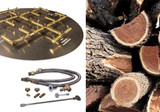Seasoning Firewood: Optimal Times for Various Wood Types
Understanding the Importance of Seasoning Firewood: A Guide to Heat Efficiency and Safety
When it comes to ensuring a warm and cozy winter, nothing is quite as vital as having properly seasoned firewood. Seasoning firewood is a process that involves reducing the moisture content of the wood to enhance its heat efficiency and safety. In this guide, we will explore the importance of seasoning firewood, the benefits it offers, and the recommended seasoning times for different types of wood.

Why Does Firewood Need to be Seasoned?
Firewood typically contains a significant amount of moisture, negatively impacting its heat source efficiency. Green or freshly cut wood can have a moisture content as high as 50%, making it difficult to ignite and burn efficiently. This excess moisture also leads to excessive smoke production and the accumulation of creosote in your chimney, posing a potential fire hazard.
Seasoning firewood is the process of drying out the wood before use. By reducing the moisture content, seasoned firewood becomes easier to ignite, burns longer, and produces more consistent heat. Additionally, properly seasoned firewood minimizes creosote buildup and decreases the risk of chimney fires, ensuring a safer environment for you and your family.
The Benefits of Seasoning Firewood
1. Increased Heat Efficiency: Seasoned firewood burns more efficiently and generates greater heat output as compared to green wood. This means that a lesser quantity of seasoned firewood can produce the same amount of heat, making it a more cost-effective option in the long run.
2. Reduced Smoke and Emissions: The high moisture content in green wood leads to excessive smoke production and harmful emissions. Seasoned firewood, with its lower moisture content, produces considerably less smoke and is a more environmentally friendly choice.
3. Improved Safety: Investing time in properly seasoning firewood significantly reduces the risk of chimney fires. With decreased creosote buildup, the chances of a dangerous chimney fire are greatly minimized.
Recommended Seasoning Times for Different Types of Wood
The seasoning time for firewood varies depending on the type of wood being used. Generally, hardwoods such as oak, maple, or birch require a longer seasoning than softwood varieties like pine or fir. Below are approximate seasoning times for different types of wood:
- Oak: 1 to 2 years
- Maple: 6 to 12 months
- Birch: 6 to 12 months
- Pine: 3 to 6 months
- Fir: 3 to 6 months
Note that these are general guidelines, and specific factors such as climate and storage conditions may affect the actual required seasoning time. It is crucial to ensure the wood is dry and has a moisture content of around 20% before using it as firewood.
By understanding the importance of seasoning firewood and following the recommended guidelines for different wood types, you can maximize heat efficiency, reduce smoke and emissions, and prioritize the safety of your home. Properly seasoned firewood will provide you with a warm and enjoyable winter experience, while also safeguarding your family and property.
Seasoning Techniques for Different Types of Wood: Factors to Consider for Optimal Drying
Properly seasoning firewood plays a crucial role in ensuring efficient and clean burning. The seasoning process involves removing moisture from the wood, making it easier to ignite and produce a hotter, longer-lasting fire. Each type of wood requires specific considerations to achieve optimal drying. Let's explore the various seasoning techniques and factors to consider for different types of wood.
1. Hardwoods
Hardwoods, such as oak, maple, ash, and beech, have a higher density and lower moisture content compared to softwoods. However, they still require proper seasoning to achieve ideal burn characteristics. Here are some factors to consider when seasoning hardwood:
- Air Circulation: Ensure adequate airflow around the woodpile by stacking the wood loosely, allowing air to reach all sides of the logs.
- Cover: Protect the wood from rain or excessive moisture by using a waterproof cover, while still allowing air circulation.
- Time: Hardwoods generally take longer to season, typically around 6 to 12 months, depending on the specific type of wood.
- Sun Exposure: Placing the woodpile in a sunny spot can help accelerate the drying process by providing natural warmth and aiding evaporation.
2. Softwoods
Softwoods, like pine, spruce, cedar, and fir, have a higher moisture content and lower density. Seasoning softwoods is equally important to enhance their burn efficiency. Consider the following techniques:
- Splitting: Softwoods benefit from being split as soon as possible after being felled. This increases the exposed surface area, enabling faster evaporation of moisture.
- Stacking: Stack the split logs in a way that allows air circulation, ensuring each piece receives adequate ventilation.
- Elevation: Place a layer of pallets or wooden planks underneath the woodpile to elevate it slightly, preventing direct ground contact and enabling air circulation from below.
- Time: Softwoods typically require about 6 to 9 months of seasoning, depending on their initial moisture content and weather conditions.
3. Exotic Woods
Exotic woods, such as cherry, walnut, and mahogany, possess unique characteristics that make them popular choices for firewood. However, due to their often higher density and slower drying rates, some additional considerations are essential:
- Splitting: As with softwoods, splitting exotic woods increases their surface area, enhancing the drying process.
- Moisture Content: Use a moisture meter to monitor the moisture content of exotic woods more closely, as they may require a longer seasoning time compared to other woods.
- Protection: Exotic woods are generally more valuable, so it's important to protect them from excessive weather exposure and potential theft.
- Patience: It's recommended to season exotic woods for at least 12 to 18 months to ensure optimal results.
Regardless of the type of wood being seasoned, it's essential to store firewood in a location that allows for proper airflow, protection from excessive moisture, and exposure to sunlight when feasible. By practicing the appropriate seasoning techniques and considering the unique factors associated with different wood types, you can ensure a well-dried and efficient firewood supply for your needs.
Timeframes for Proper Firewood Seasoning: How Long Does it Take for Various Types of Wood to Reach Ideal Moisture Levels?
Properly seasoned firewood is essential for efficient and safe wood burning. Seasoning refers to the process of reducing the moisture content in freshly-cut wood, making it ideal for use as fuel. In this article, we will explore the timeframes required for different types of wood to reach optimal moisture levels.
1. Softwoods:
Softwoods, such as pine and fir, typically have a higher sap content and thus require a longer time to season. It is recommended to plan and allow at least six to twelve months for softwoods to dry completely. The exact time frame may vary depending on factors like climate, storage conditions, and the size of the wood.
2. Hardwoods:
Hardwoods, including oak, maple, and birch, generally have a lower sap content and can season more quickly than softwoods. On average, hardwoods need to dry for approximately six to nine months. As always, external factors can influence this timeframe and need to be considered.
3. Mixed Wood:
For firewood composed of mixed types of wood, it is recommended to follow the timeframe for the type of wood that dominates the mixture. In general, it is best to err on the side of caution and allow the maximum recommended time for proper seasoning.
4. Factors Affecting Seasoning Time:
Several factors can affect how long it takes for firewood to reach ideal moisture levels:
- Climate: Dry and warm climates facilitate faster seasoning, while damp and cold climates require more time.
- Wood Size: Smaller pieces of wood will season faster compared to larger logs.
- Storage Conditions: Properly stacked and protected wood, allowing for airflow, will season more efficiently than wood left exposed to the elements.
It's crucial to regularly check the moisture content of the firewood using a moisture meter. The optimal moisture level for properly seasoned firewood is around 20% or less. Wood with higher moisture content may result in incomplete combustion, excessive smoke, and reduced heating efficiency.
In conclusion, ensuring firewood is properly seasoned is vital for effective and safe wood burning. Understanding the estimated timeframes for seasoning different types of wood can help you plan and ensure you have a sufficient supply of dry firewood for optimum performance.
Fire Pit Tips, Product Guides & Outdoor Living Advice
Fire Pit Materials: Carbon Steel, Brass & More
Let’s face it: outdoor gatherings and fire pits go together like s’mores and marshmallows. There’s s...
The Ultimate Guide to Fire Pit Sizes and Materials
If you’re reading this, chances are you’re imagining cozy nights by a dancing fire under the...
Fire Pit Safety Tips Every Homeowner Should Know
There’s something undeniably magical about kicking back in your backyard next to a warm crackling fi...
Gas vs Wood Fire Pits: Which One Fits Your Lifestyle
If you're thinking about adding a fire pit to your backyard, you’ve probably run into the classic de...
How to Choose the Perfect Fire Pit for Your Outdoor Space
Creating an inviting outdoor living area has never been more popular, especially as homeowners seek...
The Proper Gas and Wood Fire Pit Height - The Best Seating Guide for Comfort
Outdoor fire pits are a beloved focal point for patios, backyards, and gathering spaces. Whether fl...








